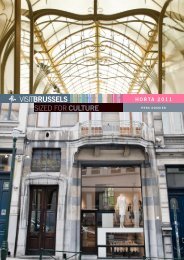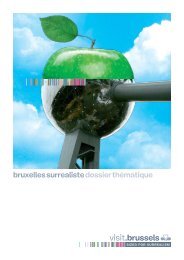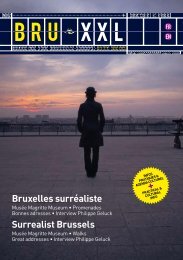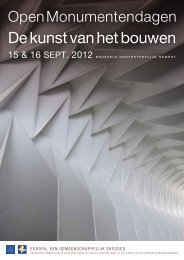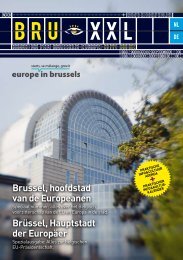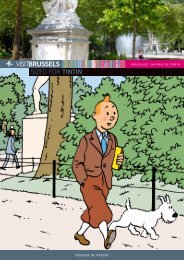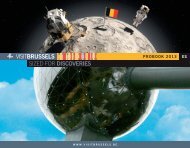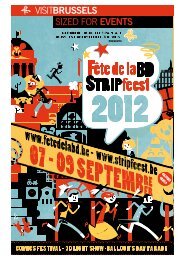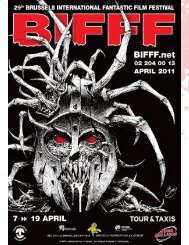Proposition for Jeff Wall exhibition to be held in ... - VisitBrussels
Proposition for Jeff Wall exhibition to be held in ... - VisitBrussels
Proposition for Jeff Wall exhibition to be held in ... - VisitBrussels
Create successful ePaper yourself
Turn your PDF publications into a flip-book with our unique Google optimized e-Paper software.
A second Mallarmé-related motive br<strong>in</strong>gs <strong>in</strong> the figure of the specta<strong>to</strong>r and serves as acounterpart <strong>to</strong> the first one. In fact, the specta<strong>to</strong>r can only appreciate the artwork if he comes <strong>in</strong><strong>to</strong>direct contact with the materialized <strong>for</strong>m of the artist‘s <strong>in</strong>itial idea. But when is this so? To thesame extent that the artist ultimately has no access <strong>to</strong> the purely conceptual idea that lies at thebasis of the artwork, the specta<strong>to</strong>r can never access that essentially abstract realm. However, ifhis <strong>in</strong>terest <strong>in</strong> the material <strong>for</strong>m of the artwork is genu<strong>in</strong>e, a variety of ―illum<strong>in</strong>ated‖ sub-ideas canshed light on the artwork <strong>for</strong> the specta<strong>to</strong>r. Sub-ideas are by def<strong>in</strong>ition related <strong>to</strong> the <strong>in</strong>itialabstraction they stem from and are equal <strong>in</strong> their diversity. This Mallarméan model helps us <strong>to</strong>expla<strong>in</strong> why <strong>Jeff</strong> <strong>Wall</strong>‘s work has received such a prolific and varied critical <strong>for</strong>tune, and still does<strong>to</strong>day. The majority of the approaches, <strong>in</strong>terpretations and critiques dedicated <strong>to</strong> his work are thefruits of such an <strong>in</strong>-depth critical labour.The catalogue‘s structure, <strong>in</strong> comb<strong>in</strong><strong>in</strong>g dialogues with citations and a myriad of entries by verydifferent authors, is a direct response <strong>to</strong> this central idea of the Mallarméan constellation, thishigher mental order that atta<strong>in</strong>s its deepest significance <strong>in</strong> cont<strong>in</strong>ually connect<strong>in</strong>g related sourcesof knowledge and <strong>in</strong>sights.The “Medium model”A third issue that needs address<strong>in</strong>g is the notion of medium. <strong>Jeff</strong> <strong>Wall</strong>‘s oeuvre can well <strong>be</strong>considered a s<strong>in</strong>gle, ongo<strong>in</strong>g artist‘s reflection on the chang<strong>in</strong>g conditions of his medium:pho<strong>to</strong>graphy. In us<strong>in</strong>g such a generic term, we have <strong>to</strong> rema<strong>in</strong> alert <strong>be</strong>cause the word ―medium‖,when applied <strong>to</strong> the arts, functions as a l<strong>in</strong>guistic ―shifter‖: it only receives its significance from thecontext <strong>in</strong> which it is used. And even so, one can impossibly pretend that the medium ofpho<strong>to</strong>graphy is def<strong>in</strong>ed by the equipment needed and the techniques applied <strong>in</strong> the production ofa picture. Stay<strong>in</strong>g clear here from a more fundamental debate, we might <strong>for</strong> the time <strong>be</strong><strong>in</strong>g def<strong>in</strong>e―medium‖ as an ―<strong>in</strong>strumentalizer‖ that operates <strong>in</strong> <strong>be</strong>tween the notion of métier and the creationof art.On another level, where the notion of the medium can <strong>be</strong> unders<strong>to</strong>od <strong>in</strong> its his<strong>to</strong>ricalconsequences, we could dist<strong>in</strong>guish <strong>be</strong>tween a medium that has <strong>be</strong>en stable <strong>in</strong> its development<strong>for</strong> ages – pa<strong>in</strong>t<strong>in</strong>g, <strong>for</strong> <strong>in</strong>stance – and a medium like pho<strong>to</strong>graphy that has gone through majorparadigmatic shifts over the last decades, slowly acquir<strong>in</strong>g a more stable, def<strong>in</strong>ite shape. In all thestages of his development as an artist, <strong>Jeff</strong> <strong>Wall</strong> has <strong>be</strong>en driven by a desire <strong>to</strong> make a significantcontribution <strong>to</strong> the affirmationof his medium <strong>in</strong> its canonical relation <strong>to</strong> other visual arts. And nowhere <strong>in</strong> his œuvre is this idea –that spr<strong>in</strong>gs up <strong>in</strong> this <strong>exhibition</strong> as a leitmotif – so delightfully developed as <strong>in</strong> a Certa<strong>in</strong> Gust ofW<strong>in</strong>d.<strong>Jeff</strong> <strong>Wall</strong> stages this large-scale pho<strong>to</strong>graph, conceived as a ―remake‖ of a situation depicted <strong>in</strong> apr<strong>in</strong>t by the famous Japanese master Hokusai, <strong>in</strong> 1993, some 160 years after it was first pr<strong>in</strong>ted.If we compare it <strong>to</strong> the orig<strong>in</strong>al copy, we are amazed <strong>to</strong> see how m<strong>in</strong>utely <strong>Wall</strong> has reconstructeda scene that <strong>in</strong> fact amounted <strong>to</strong> pure chance: under the pull of a ―sudden gust of w<strong>in</strong>d‖, one ofthe figures <strong>in</strong> the open suburban landscape lets go of a pile of papers that the w<strong>in</strong>d blows away.In <strong>Wall</strong>‘s pic<strong>to</strong>rial grammar, this picture can <strong>be</strong> read as a qu<strong>in</strong>tessential example of the artist‘sunderstand<strong>in</strong>g of pho<strong>to</strong>graphy as a <strong>for</strong>m of c<strong>in</strong>ema<strong>to</strong>graphy. On a deeper level, however,someth<strong>in</strong>g else appears <strong>to</strong> <strong>be</strong> at stake here.Just like his somewhat older colleague Utamaro, Hokusai built his last<strong>in</strong>g reputation on his skilledpractice of Ukiyo-e, Japanese woodblock pr<strong>in</strong>t<strong>in</strong>g. In late 18th-century Japan, this medium wasconsidered a popular art <strong>for</strong>m – wholly dist<strong>in</strong>ct from traditional Japanese pa<strong>in</strong>t<strong>in</strong>g and sculpture –that gave dar<strong>in</strong>g evidence of a remarkable sense of li<strong>be</strong>rty and spatial audacity <strong>in</strong> its depiction ofscenes of everyday life <strong>in</strong> a <strong>to</strong>wn‘s popular neighbourhoods. Although what rema<strong>in</strong>s fasc<strong>in</strong>at<strong>in</strong>g isthe extent <strong>to</strong> which the conditions <strong>for</strong> approach<strong>in</strong>g traditional environments <strong>in</strong> a novel manner9





